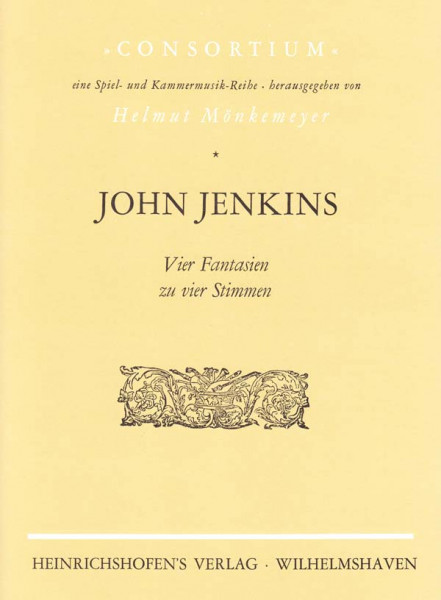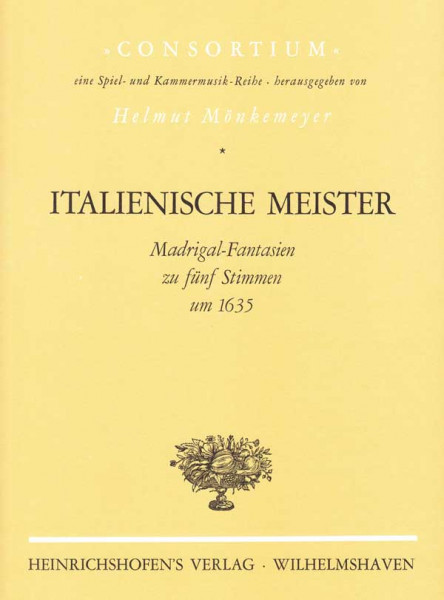No results were found for the filter!
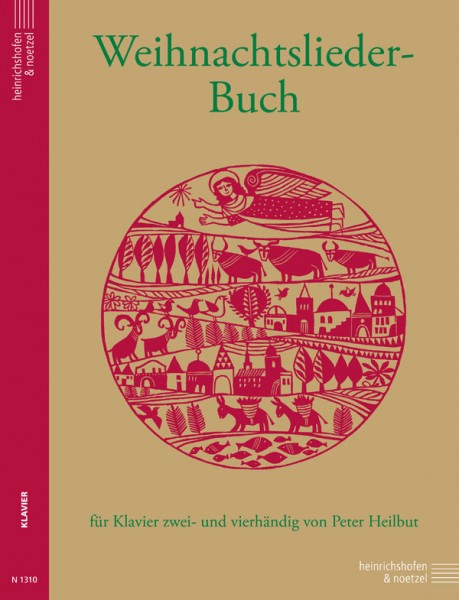
Peter Heilbut
Weihnachtslieder-Buch Klavier, zweihändig (vierhändig)
Für das weihnachtliche Musizieren am Klavier bietet diese Ausgabe eine Fülle an Variationsmöglichkeiten. Peter Heilbut legt bekannte deutsche Weihnachtslieder in sehr leichten zweihändigen Fassungen vor. Fortgeschrittenen Schülern steht zu vielen Liedern eine weitere Version in einem höheren Schwierigkeitsgrad zur Verfügung. Außerdem gibt es zu den meisten Liedern eine vierhändige Variante. Der Vortrag dieser Lieder kann mit Hilfe der verschiedenen Sätze von Strophe zu Strophe abwechslungsreich gestaltet werden. Die Stücke sind auch einzeln als pdf-Datei erhältlich. Klicken Sie auf das Drop-down-Menü unter "Ausgabe (bitte auswählen)" Inhalt: 1. Alle Jahre wieder 2. Ihr Kinderlein kommet 3. O Tannenbaum, o Tannenbaum 4. Lasst uns froh und munter sein 5. O du fröhliche 6. Stille Nacht, heilige Nacht 7. Sankt Nikolaus 8. Pille, palle, polle 9. Es ist ein Ros' entsprungen 10. Vom Himmel hoch da komm ich her 11. Was soll das bedeuten 12. Lippai, steh auf vom Schlaf 13. Ihr Hirten erwacht 14. Kommet, ihr Hirten 15. O laufet, ihr Hirten 16. Als ich bei meinen Schafen wacht 17. Vom Himmel hoch ihr Englein kommt 18. Inmitten der Nacht 19. Maria durch ein Dornwald ging 20. Joseph, lieber Joseph mein 21. Weihnachtsmusik 22. Still, still, still 23. Lasst uns das Kindlein wiegen 24. O Jesulein zart 25. Ich steh' an deiner Krippe hier 26. Es kommt ein Schiff geladen 27. Puer nobis nascitur 28. Quem pastores laudavere 29. In dulci jubilo 30. Pastorale "In dulci jubilo" 31. O Heiland, reiß die Himmel auf
Mehr From €1.99 *
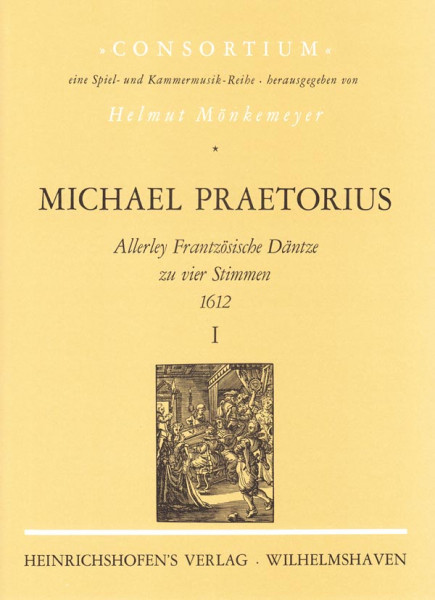
Michael Praetorius
Allerley Frantzösische Däntze zu vier Stimmen 1612, I Stimmen komplett: N 1311-Sti Stimme 1 Cantus (Sopran): N1311-Sti1 Stimme 2 Altus (Sopran): N 1311-Sti2 Stimme 3 Tenor (Alt): N 1311-Sti3 Stimme 4 Bassus (Tenor) - Violinschlüssel: N 1311-Sti4 Stimme 5 Bassus (Tenor) - Bassschlüssel: N 1311-Sti5
Mehr €12.00 *
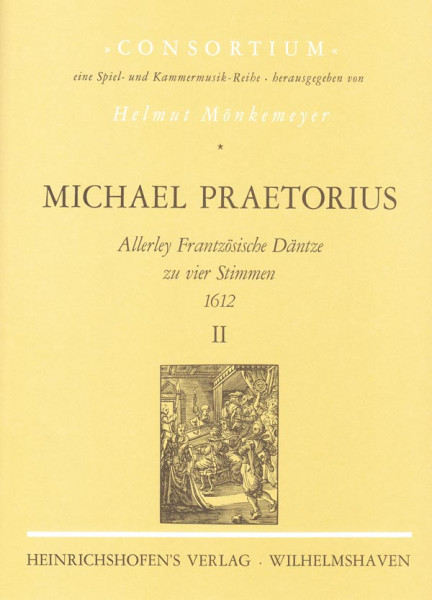
Michael Praetorius
Allerley Frantzösische Däntze zu vier Stimmen (1612) II Stimmen komplett: N 1312-Sti Stimme 1: Cantus (Sopran) N 1312-Sti1 Stimme 2: Altus (Sopran oder Alt) N 1312-Sti2 Stimme 3: Tenor (Alt oder Tenor) Violinschlüssel N 1312-Sti3 Stimme 4: Tenor (Alt oder Tenor) Bassschlüssel N 1312-Sti4 Stimme 5: Bass N 1312-Sti5
Mehr €12.00 *
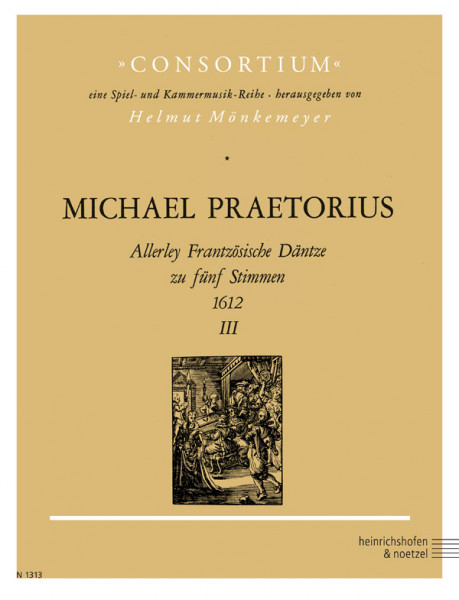
Michael Praetorius
Allerley Frantzösische Däntze zu fünf Stimmen 1612 III Stimmen komplett: N 1313-Sti Stimme 1: Cantus (Sopran) N 1313-Sti1 Stimme 2: Altus (Sopran) N 1313-Sti2 Stimme 3: Tenor (Alt) N 1313-Sti3 Stimme 4: Quintus (Tenor) Violinschlüssel N 1313-Sti4 Stimme 5: Quintus (Tenor) Bassschlüssel N 1313-Sti5 Stimme 6: Bass N 1313-Sti6
Mehr €13.00 *
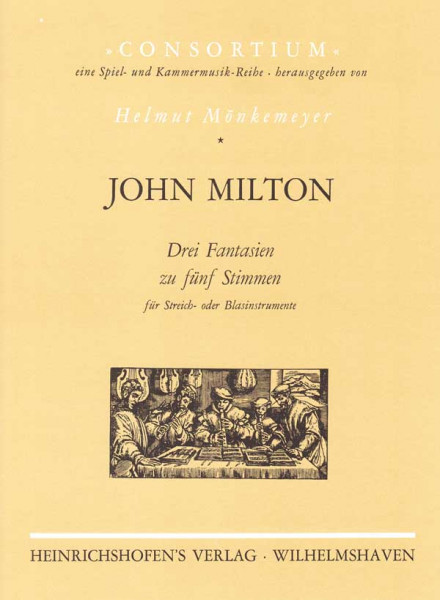
John Milton
Drei Fantasien zu fünf Stimmen Stimmen einzeln: N1315-Sti1 N1315-Sti2 N1315-Sti3 N1315-Sti4(Altschlüssel) N 1315-Sti4(Violinschlüssel) N1315-Sti5
Mehr €20.00 *
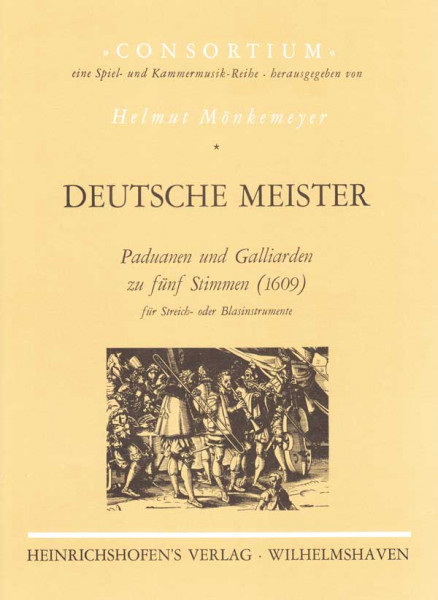
Helmut Mönkemeyer
Deutsche Meister. Paduanen und Galliarden zu 5 Stimmen... Stimme 1: N1317-Sti1 Stimme 2: N 1317-Sti2 Stimme 3: N 1317-Sti3 Stimme 4: N 1317-Sti4-BSchl Stimme 4: N 1317-Sti4-VSchl Stimme 5: N 1317-Sti5
Mehr €12.00 *
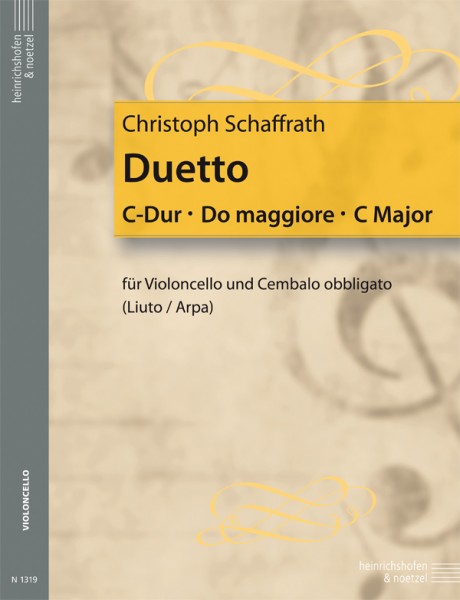
Christoph Schaffrath
Duetto in C major Violoncello and harpsichord obligato (lute , harp)
Christoph Schaffrath (1709-1763) was one of the important musicians and composers that the music-loving Frederick II of Prussia gathered around him. He can be described as one of the most interesting and imaginative composers of the Berlin circle. In addition to overtures, symphonies and quartets, he mainly wrote harpsichord works and chamber music in which the keyboard instrument plays a leading role. The editor's work extends to compiling the score, correcting some errors and setting out the continuo parts. Additions to the score are indicated as such by small notes, brackets or dotted slurs. Content: - Allegretto - Adagio - Allegro
Mehr €15.00 *
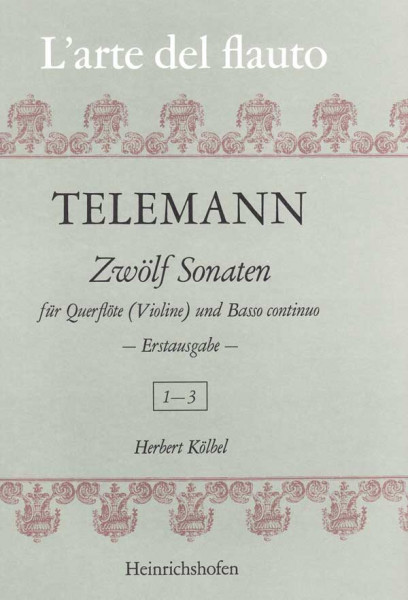
Georg Philipp Telemann
Twelve sonatas | sonatas 1 - 3 | volume 1 Flute (violin) and Basso continuo
First edition This edition is based on a manuscript from the Staatsbibliothek Berlin, Preußischer Kulturbesitz, Musikabteilung. It comes from the estate of Telemann, who gave it to his grandson Georg Michael Telemann (1748-1831). G. Poelchau acquired the manuscript in 1834 with a pack of music stored in a church tower in Riga. From Poelchau's estate († 1836) the sonata work came to the Royal Library in Berlin. The sonatas are dedicated to the brothers Rudolf, Hieronymus and Johannes Wilhelm Burmester of a Hamburg patrician family dated 1 March 1734, with the note that they follow the ‘12 methodical sonatas’, which were also dedicated to the first two brothers. The close connection between the two large sonata works can be found in their valuable musical content, in the sequence of movements (slow, fast, slow, fast), and in the succession of keys (C-a-D-h-E-F-d-G-e-A-f sharp-g). The bass lines are often involved in the theme. Occasionally we are reminded of J.S. Bach's inventions. In the title, the violin is named as the solo instrument before the flute, as several sonatas are unmistakably written “violinistically” without this hindering their playability for flute. The present edition adheres strictly to the manuscript. Suggestions for dynamics are indicated as such by brackets, as are those for articulation (by dotted lines), which may differ for violinists from those intended for flute. Experienced players should use the original figured bass for their own interpretation. The 12 sonatas made available to the public here for the first time are among the best compositions of this kind by Telemann, who dedicated them to 'connoisseurs and lovers' with the wish '...faire une bonne partie de Vos amusements'. The sonatas will fulfill this purpose today just as they did at that time.
Mehr €27.50 *
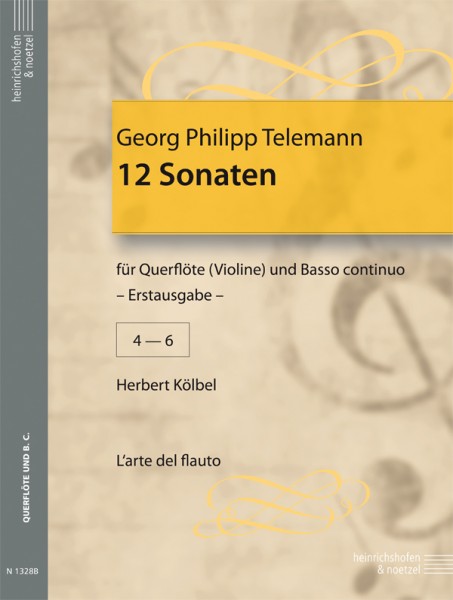
Georg Philipp Telemann
Twelve sonatas | sonatas 4 - 6 | volume 2 Flute (violin) and basso continuo
First edition This edition is based on a manuscript from the Staatsbibliothek Berlin, Preußischer Kulturbesitz, Musikabteilung. It comes from the estate of Telemann, who gave it to his grandson Georg Michael Telemann (1748-1831). G. Poelchau acquired the manuscript in 1834 with a pack of music stored in a church tower in Riga. From Poelchau's estate († 1836) the sonata work came to the Royal Library in Berlin. The sonatas are dedicated to the brothers Rudolf, Hieronymus and Johannes Wilhelm Burmester of a Hamburg patrician family dated 1 March 1734, with the note that they follow the ‘12 methodical sonatas’, which were also dedicated to the first two brothers. The close connection between the two large sonata works can be found in their valuable musical content, in the sequence of movements (slow, fast, slow, fast), and in the succession of keys (C-a-D-h-E-F-d-G-e-A-f sharp-g). The bass lines are often involved in the theme. Occasionally we are reminded of J.S. Bach's inventions. In the title, the violin is named as the solo instrument before the flute, as several sonatas are unmistakably written “violinistically” without this hindering their playability for flute. The present edition adheres strictly to the manuscript. Suggestions for dynamics are indicated as such by brackets, as are those for articulation (by dotted lines), which may differ for violinists from those intended for flute. Experienced players should use the original figured bass for their own interpretation. The 12 sonatas made available to the public here for the first time are among the best compositions of this kind by Telemann, who dedicated them to ' connoisseurs and lovers' with the wish '. ..faire une bonne partie de Vos amusements' . The sonatas will fulfill this purpose today just as they did at that time.
Mehr €27.50 *
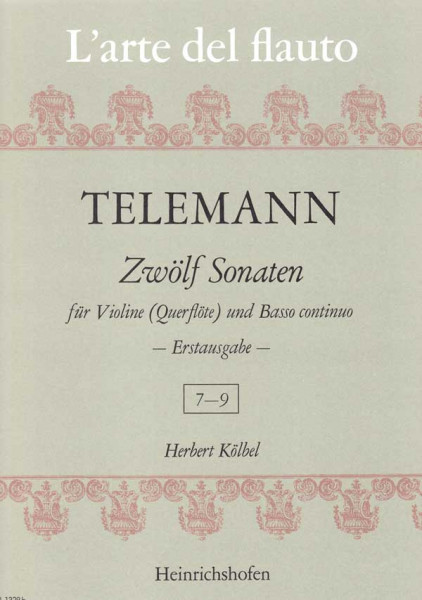
Georg Philipp Telemann
Twelve sonatas | sonatas 7 - 9 | volume 3 Flute (violin) and basso continuo
First edition This edition is based on a manuscript from the Staatsbibliothek Berlin, Preußischer Kulturbesitz, Musikabteilung. It comes from the estate of Telemann, who gave it to his grandson Georg Michael Telemann (1748-1831). G. Poelchau acquired the manuscript in 1834 with a pack of music stored in a church tower in Riga. From Poelchau's estate († 1836) the sonata work came to the Royal Library in Berlin. The sonatas are dedicated to the brothers Rudolf, Hieronymus and Johannes Wilhelm Burmester of a Hamburg patrician family dated 1 March 1734, with the note that they follow the ‘12 methodical sonatas’, which were also dedicated to the first two brothers. The close connection between the two large sonata works can be found in their valuable musical content, in the sequence of movements (slow, fast, slow, fast), and in the succession of keys (C-a-D-h-E-F-d-G-e-A-f sharp-g). The bass lines are often involved in the theme. Occasionally we are reminded of J.S. Bach's inventions. In the title, the violin is named as the solo instrument before the flute, as several sonatas are unmistakably written “violinistically” without this hindering their playability for flute. The present edition adheres strictly to the manuscript. Suggestions for dynamics are indicated as such by brackets, as are those for articulation (by dotted lines), which may differ for violinists from those intended for flute. Experienced players should use the original figured bass for their own interpretation. The 12 sonatas made available to the public here for the first time are among the best compositions of this kind by Telemann, who dedicated them to 'connoisseurs and lovers' with the wish '...faire une bonne partie de Vos amusements'. The sonatas will fulfill this purpose today just as they did at that time.
Mehr €27.50 *
Viewed

